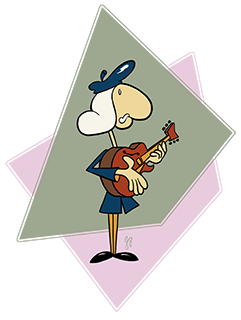The typical way to play the Altered scale (aka Super-Locrian), is to sight the root of the Altered scale on the root of the dominant. Alternatively, you can sight the Melodic Minor's root on the b9 of the V chord -- one semi-tone up from the root of the V.
The Super-Locrian/Altered scale is really the 7th mode of the Melodic Minor -- the root of the Altered scale is the 7th degree of the Melodic Minor scale. Additionally, there are other modes of the Melodic Minor that work nicely over dominant chords in other situations.
The Lydian b7 (4th mode of Melodic Minor) works great over Dominants with a #11. If you are familiar sighting the altered scale, you can sight the root of the altered scale on the #11 of the Dominant. Or you can sight the root of the Jazz Minor on the 5 of the V.
For a Dominant with a #5, you can play the Mixolydian b6 - the fifth mode of the Melodic Minor. Sight the start of the altered on the 3rd of the V chord you are playing over. Otherwise, sight the Melodic Minor starting on the 4.
Finally, a Dorian b2 (3rd mode of the Melodic Minor) works over a Dominant with a #9 or a b9. Sight the altered scale starting at the V chord's 13. Or sight the Melodic Minor on the b7.
I learned the Melodic Minor via the Altered Scale, so I tend to sight with the Major 7 of the Melodic Minor. But it is really best to sight the Melodic Minor. When you first learn the Altered scale, your melodic lines will probably sound quite foreign if you think of the 7 of the Melodic minor as the root -- similar to when you attempt to play the Locrian mode out of context. The 7's of the scale are really pulling the westerner's ear toward the next tone up, which is the root of the key.
If you play lines with the Melodic Minor in mind, you will still be creating tension on the V with the outside note, but the lines will sound a little more familiar and groovy somehow. The best way to inflect the Melodic Minor sound is to focus on notes in the Melodic Minor arpeggio 1, b3, 5, 7. This isn't the end approach to take with the substitute modes, but it worth starting with. By focusing on the Melodic Minor arpeggio, you will begin to see the other modes in relationship to the Melodic Minor harmony.
The chart provided shows all the Super-Locrian, Lydian b7, Mixolydian b6 and Dorian b9 modes against the Mixolydian of a V chord.
In addition, I've broken each of my mode boxes out and repeated the information for each neck position. The name 'r6-vi' Aeolian Box is my description of the 4-5 fret position where the Aeolian Mode for would start with its root on the 6th guitar string (low E). That is the shape of the notes in the position, but the V is still the root in this context.
With the mode boxes, I've also stripped this box down to the arpeggios for each mode. The yellow ring indicates the Root of the Melodic Minor. Therefore, for the right-hand, stripped down box of the Super-Lociran, Lydian b7, etc., shows the Melodic Minor arpeggio, with the yellow ring as the root. This outlines how to play a really strong Jazz-Minor sound against these altered dominants.
Try looping a passage with an altered dominant like a Dom #11, and find the mode of the Melodic Minor (Lydian b7 in this case) that works best over it. Play the melodic minor mode over the V chord -- maybe even imagine the arpeggio of the V chord dimly sitting 'underneath' the mode you are playing. Then try and make a line solely comprised of the Melodic Minor arpeggio before resolving to the next chord. Try this in various positions over the neck until you start to see the juxtaposed relationship. You should practice until you can see your Mixolydian notes or your V arpeggio, and then immediately super-impose the applicable Melodic Minor mode, understanding the 'essential tones' (3rd & 7th) of the substitute mode.
Once you are facile at seeing each mode in relation to the Dominant arpeggio the V, you can begin focusing on structuring lines that really capture the essential tones of the V chord while also including the altered notes of the chord on the lead sheet, pulling you toward resolution with an essential tone of the one.
| altereds_over_dominant.pdf |

 RSS Feed
RSS Feed
